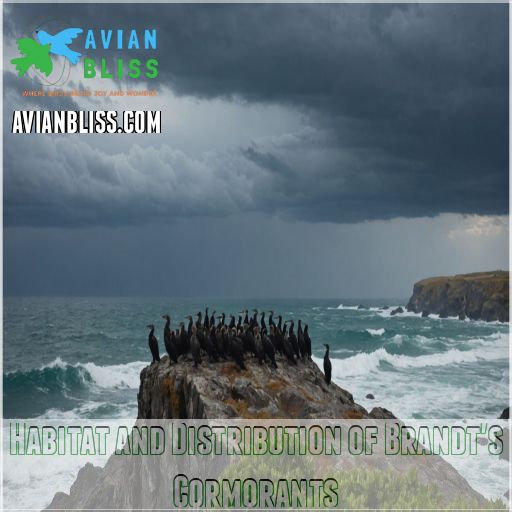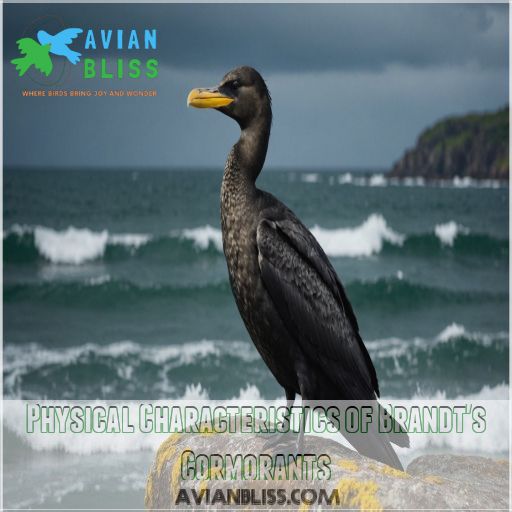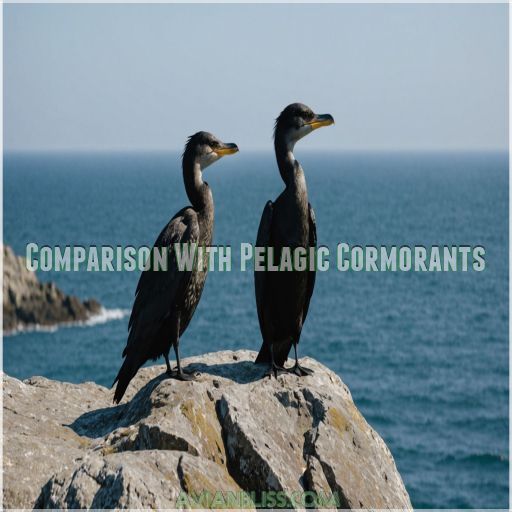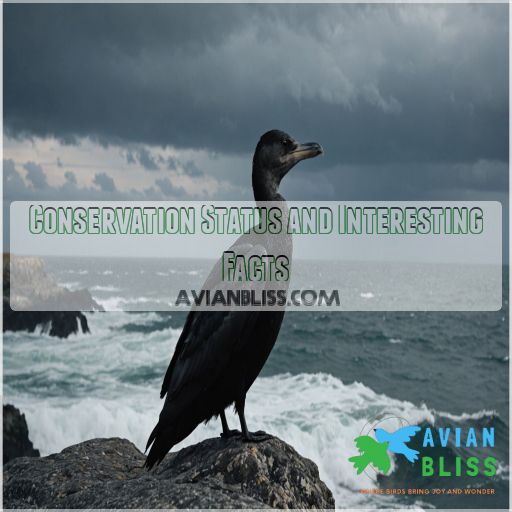This site is supported by our readers. We may earn a commission, at no cost to you, if you purchase through links.

Their hooked beaks and webbed feet make them superb underwater hunters, tackling small fish with friends in true team spirit. Despite flocking to less crowded coasts, the adaptable Brandt’s Cormorant isn’t shy about using man-made structures for nesting.
Intrigued? Stick around to uncover more about their quirky habits and heroic conservation efforts unfolding along our coasts like those protecting Florida’s eagles.
Table Of Contents
- Key Takeaways
- Habitat and Distribution of Brandt’s Cormorants
- Physical Characteristics of Brandt’s Cormorants
- Behavior and Diet of Brandt’s Cormorants
- Comparison With Pelagic Cormorants
- Conservation Status and Interesting Facts
- Frequently Asked Questions (FAQs)
- What are some interesting facts about Brandt’s cormorant?
- What is the difference between Brandt’s and pelagic cormorants?
- Where do Brandt’s cormorants live?
- How deep can Brandt’s cormorants dive?
- What are the breeding rituals of Brandt’s cormorants?
- How long do Brandt’s cormorants live?
- What threats do Brandt’s cormorants face?
- At what age do Brandt’s cormorants start breeding?
- How do Brandt’s cormorants communicate with each other?
- Conclusion
Key Takeaways
- Adaptation Pros: Imagine being a coastal cliff explorer; that’s brandt’s cormorant for you. They thrive on marine coastlines from Alaska to Baja California, even finding man-made sites perfect for nesting. Whether dodging fishing boats or embracing pollution challenges, their resilience in human-altered landscapes is truly impressive.
- Diving Dynamos: If there were an Olympic event for diving, Brandt’s Cormorants would surely win gold. With cobalt-blue throats glistening, they plunge over 200 feet, expertly hunting fish and squid. Their hooked beaks and webbed feet make catching prey a breeze, often turning the hunt into a synchronized dance with fellow cormorants.
- Social Savvy: These birds know the secret to success is teamwork. Nesting in dense colonies, they’re like feathered socialites at a gala. They establish hierarchies, share meals, and use grunts and croaks to stay connected. Talk about a thriving community!
- Conservation Warriors: Facing threats like climate change and pollution, Brandt’s Cormorants are on a conservation journey. Efforts to protect their habitats and manage fishing pressures bring hope. So, next time you see these charismatic birds, remember, they’re more than just beautiful—they’re survivors with a cause.
Habitat and Distribution of Brandt’s Cormorants
In "Brandt’s Cormorant: a Closer Look at Their Habits & Habitat," you’re going on a journey along the pacific coast from Alaska to California to explore where these birds call home.
They’ll amuse you with their choice to stick to marine coastlines and islands, avoiding crowded beaches and keeping a respectable distance from human developments.
Geographic Range and Migration Patterns
Brandt’s cormorants roam far and wide, with their migratory patterns shaped by the seasons.
Their breeding grounds dot the Pacific Coast, from Alaska to Baja California.
Come winter, they flock to sheltered bays, estuaries, and even freshwater lakes, seeking refuge from the chill.
This adaptable seabird’s range spans 3 countries – the U.S., Canada, and Mexico.
Coastal and Island Habitats
Imagine strolling along coastal cliffs: these places offer nesting sites for cormorants.
Perfectly suited to island biogeography, these birds juggle food sources among the waves.
Humans can ruffle feathers—pollution impacts habitats—yet conservation challenges spark hope.
Cormorants might chatter about tides, but trust, they’ve honed survival as a fine art, gracefully adapting to nature’s whims.
Freshwater and Estuarine Environments
Picture coastal escapades and then, explore freshwater and estuarine environments where Brandt’s Cormorants show unique adaptations.
In these settings, they:
- Flaunt freshwater adaptations enabling survival in varying salinity levels.
- Display estuarine salinity tolerance, finding balance amidst shifting tides.
- Engage in a playful yet serious competition for resources.
Pollution impacts them, highlighting conservation challenges to address.
Adaptability to Human-Altered Landscapes
Just like how fish smoothly navigate bustling streams, these birds adapt to human-altered landscapes. They thrive amidst coastal development impacts and handle interactions with the fishing industry with aplomb. Amid pollution concerns and health effects, their resilience shines. Consider:
| Challenge | Adaptation Strategy |
|---|---|
| Human-induced changes | Adjust nesting sites |
| Coastal development impacts | Utilize man-made structures |
| Fishing industry interactions | Scavenging near boats |
| Pollution and health effects | Tolerance increase |
| Conservation challenges | Collaborative initiatives |
Physical Characteristics of Brandt’s Cormorants
Brandt’s Cormorants are striking seabirds with a unique appearance.
From their vivid cobalt-blue throat patches and wispy white head feathers to their hooked beaks and large webbed feet, these expert divers are easily distinguished from other cormorant species. (Source)
Plumage and Coloration Patterns
Shifting from their specific habitat in coastal areas, it’s fascinating to observe Brandt’s Cormorants’ plumage and coloration patterns.
During the breeding season, expect vivid changes:
- Bright Cobalt-Blue Throat Patch: Signals readiness for courtship.
- Juvenile Plumage: Brownish overall, a rite of passage!
- Seasonal Variations: Colors shimmer based on light, adding mystery to their identity (Source).
Beak Shape and Size
Before getting to their beak, consider Brandt’s cormorant’s vibrant plumage.
Their beak shape and size are a clear sign of evolution.
Watch how this marvel captures prey with precision and efficiency.
Isn’t it fascinating how their beak adapts to size variation for the best feeding?
This tool showcases nature’s artistry, marrying form with function.
| Feature | Description | Function |
|---|---|---|
| Shape | Long, hooked | Capture prey efficiently |
| Size Variation | Adaptable | Suits feeding needs |
| Evolution | Adaptive trait | Enhances survival |
| Feeding Efficiency | Highly efficient | Best foraging |
Leg and Foot Structure
The Brandt’s Cormorant doesn’t just sport a unique beak; its legs and webbed feet are swimming powerhouses.
These feet act like paddles, making prey capture in the water a breeze.
They’re not the best walkers on land, but they’re evolutionary marvels in water.
Imagine wearing flippers while shopping—a slow land pace, but spectacular in the sea!
Distinguishing Features From Other Cormorants
Brandt’s cormorants have a few distinctive features that set them apart.
Their heads are smaller and more streamlined compared to other cormorants.
Their wingspan is also slightly shorter, and their bills have a distinctive yellow-orange hue.
Look for their long, slender tails and their tendency to nest in dense colonies on coastal cliffs and islands.
Behavior and Diet of Brandt’s Cormorants
Get ready to be amazed as you uncover the remarkable foraging techniques of Brandt’s Cormorants, these expert divers and skilled hunters manage to catch fish deep beneath the ocean while overcoming breeding challenges with their distinctive mating strategies .
You’ll also learn about their social lives, how they form colonies for safety and success, and their appetites for a diet rich in fish, with occasional shrimp and crabs to spice things up .
Foraging Techniques and Strategies
Imagine you’re watching Brandt’s Cormorants dive gracefully at popular dive locations.
These birds are group hunting experts, using teamwork to outsmart their prey and outpace competition.
Their tight formations and slick synchronized moves could rival a seasoned dance crew.
By carefully measuring efficiency metrics, they catch prey with an impressive speed, ensuring every hunt ends in success.
Diet Composition and Prey Preferences
After honing those clever foraging strategies, you’ll find these cormorants crave a varied menu.
They primarily feast on small fish and squid, though their choices sway with seasonal variation and prey size.
Competition with neighbors adds spice to mealtime.
Despite human impact, they adapt well, skillfully balancing foraging success with environmental challenges, keeping them thriving along coastlines.
Social Behavior and Colony Formation
Brandt’s Cormorants are highly social birds, nesting in dense colonies on coastal cliffs and islands. They establish a clear social hierarchy, with dominant birds securing the best nesting sites. Their vocalizations, including grunts and croaks, help maintain group cohesion.
Successful colony formation is key to their breeding success in the California Current ecosystem.
- Nest in dense colonies on coastal cliffs and islands
- Establish clear social hierarchy for prime nesting sites
- Use vocalizations like grunts and croaks to maintain group unity
- Successful colony formation is essential for breeding in their habitat
- Highly adaptable to human-altered landscapes near the coast
Mating and Breeding Habits
For mating, these cormorants sure know how to "put a ring on it" via elaborate courtship displays.
Breeding seasons vary, but they usually choose nesting sites with ample food.
Success in chick-rearing hinges on timing and teamwork.
You’ll admire their resilience, working together for reproductive success while facing the wild’s challenges head-on.
Comparison With Pelagic Cormorants
You’re about to explore how Brandt’s Cormorants stack up against their pelagic counterparts in looks, hangouts, and quirky habits.
From striking physical traits to their favorite seaside spots, this comparison will have you spotting differences and similarities like a pro.
Key Differences in Physical Characteristics
You’ve just explored Brandt’s Cormorant’s diet. Now, picture them and their cousin, the Pelagic Cormorant.
The Brandt’s size dwarfs the pelagic, with a broader wingspan and a stouter body shape.
You’ll notice beak variations—Brandt’s is thicker, perfect for tough prey. Picture pelagic’s slender head shape.
Wings flapping like batting eyelashes, these distinctions pop, right?
Variations in Habitat and Distribution
While Brandt’s cormorants share some habitat preferences with their pelagic cousins, they tend to favor more coastal and island environments.
Their distribution often centers around areas with abundant food sources, such as bays, estuaries, and rocky shorelines.
Breeding colonies are commonly found on cliffs, ledges, and human-made structures close to the water’s edge.
Behavioral Differences and Adaptations
Looking at Brandt’s cormorants, you’ll notice their lively social dynamics in breeding colonies.
Nesting involves creativity—using seaweed like it’s going out of fashion.
These birds, unlike their pelagic cousins, stick close to the coast, perfecting predator avoidance.
Migration patterns differ too; Brandt’s are less adventurous. They’re classic homebodies, reminding us that exploring isn’t everyone’s cup of tea.
Similarities and Overlapping Traits
Both Brandt’s and Pelagic Cormorants share common ground in coastal habits and diets.
Picture two neighbors who often borrow sugar; they thrive where the ocean supplies ample fish.
Their sleek, water-friendly morphology helps in diving, and their breeding territories sometimes overlap like friendly rivals.
These similarities highlight shared adaptations, reflecting nature’s clever blueprint balancing competition and collaboration.
Conservation Status and Interesting Facts
You’ll find Brandt’s Cormorants fascinating not just for their striking blue throat patches during breeding season but also because they’re among the least vocal cormorants, making only soft noises barely heard a few feet away.
Marine Reserve habitats need careful monitoring since climate change poses risks, even as they enjoy a "Least Concern" status, and conservationists continue protecting these charismatic birds from pollution and other threats to their rocky coastal homes (Source).
Population Trends and Threats
Regrettably, Brandt’s cormorant populations face several threats. Overfishing, climate change, oil spills, habitat loss, and disease outbreaks have all contributed to their declining numbers.
To address these challenges, conservation efforts focus on:
- Protecting critical nesting and foraging habitats
- Reducing bycatch and overfishing
- Mitigating the impacts of oil spills and climate change
Unique Characteristics and Adaptations
You’ve met Brandt’s Cormorant’s population threats, now let’s chat about their unique traits.
Their diving proficiency is like an Olympic swimmer’s, making them fishing masters.
Flight efficiency? Think graceful aerial acrobats like the Black-Legged Kittiwake like the Black-Legged Kittiwake!
Ever wonder how they handle salty seas? They rock a superb salt gland function.
During breeding rituals, their plumage transforms into a dramatic show, capturing eyes and hearts alike.
Interesting Behaviors and Social Interactions
In the amazing world of Brandt’s Cormorants, courtship rituals resemble an avian ballet. You’ll witness tender moments:
- Nest building: Precision and teamwork.
- Prey sharing: A token of affection.
- Communal roosting: Nights spent chatting.
- Chick rearing: Parenting adventures.
- Social dynamics: A sitcom by the sea.
These dynamic interactions weave a tapestry of life that thrives on connection and cooperation.
Conservation Efforts and Management Strategies
After marveling at their quirky social antics, let’s tackle how you can help save Brandt’s Cormorants.
Conservation efforts include fishing regulations to protect their food, habitat restoration projects for nesting, and diligent population monitoring.
Partnerships tackle human-wildlife conflicts, combining science and community.
Every bit helps these fascinating birds thrive, so support conservation and be part of the solution!
Frequently Asked Questions (FAQs)
What are some interesting facts about Brandt’s cormorant?
Brandt’s cormorants are expert divers that can plunge over 200 feet to catch fish and shellfish.
Their striking blue throat patches and wispy white head feathers make them a beautiful sight along the Pacific coast.
What is the difference between Brandt’s and pelagic cormorants?
Imagine you’re comparing apples to oranges.
You’d notice pelagic ones are smaller, with glossy plumage and a red face patch during breeding.
Conversely, Brandt’s are robust, with vibrant blue throat patches, both enjoying the salty air.
Where do Brandt’s cormorants live?
Brandt’s cormorants thrive along the Pacific Coast, rarely straying inland, especially favoring kelp beds and coastal areas like inlets and bays.
Even nonbreeders stay near shores, embracing the ocean’s bustling tunes through rocky island roosts.
How deep can Brandt’s cormorants dive?
Diving like a fearless acrobat, you might plunge down to 230 feet underwater if you were a cormorant.
These birds expertly hunt fish, pushing the boundaries of marine freedom with their adaptable aquatic ballet, much like the cooperative fishing techniques of American White Pelicans.
What are the breeding rituals of Brandt’s cormorants?
You’ll be captivated by the intricate courtship rituals of Brandt’s cormorants.
They engage in elaborate displays, including synchronized swimming, beak-fencing, and nest-building – a true avian ballet that’s sure to delight birdwatchers.
How long do Brandt’s cormorants live?
Imagine a life as free and easy as a bird’s daily flight.
Expect these seabirds to live for 17 years or more.
They’ve got the know-how to navigate the winds and waves into their golden years!
What threats do Brandt’s cormorants face?
Imagine a brave explorer dodging obstacles in a treacherous jungle.
That’s how Brandt’s cormorants face threats like habitat loss, pollution, and overfishing,
with climate change acting as an ever-present specter looming over their survival.
At what age do Brandt’s cormorants start breeding?
Brandt’s cormorants typically begin breeding at 2-3 years old.
It’s like they’re just getting their feet wet in parenting, embracing the adventure of starting a family while juggling the perils of ocean life.
How do Brandt’s cormorants communicate with each other?
You’ll find Brandt’s cormorants communicate through a variety of vocalizations – from grunts and croaks to high-pitched whistles.
They use these sounds to coordinate nesting, defend territories, and signal to their flock.
Conclusion
Don’t let the Brandt’s Cormorant’s ordinary name fool you; they’re genuinely fascinating.
You’ve explored their vibrant habitats, nimble underwater hunting, and charming social antics.
With their clever nesting adaptability, they thrive in both wild and human-modified environments.
Though facing threats, conservation initiatives promise a hopeful future.
So next time you’re near a coastal cliff, keep an eye out for these majestic blue-throated divers; you might just witness their dramatic, synchronized fishing leaps firsthand.








